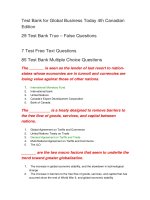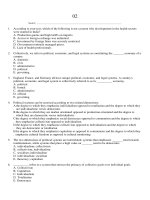individual assignment mkt101 fa23 explain how the internet has transformed the way in which we do business today
Bạn đang xem bản rút gọn của tài liệu. Xem và tải ngay bản đầy đủ của tài liệu tại đây (789 KB, 13 trang )
<span class="text_page_counter">Trang 1</span><div class="page_container" data-page="1">
Individual Assignment – MKT101 - FA23Class: FIN1803
Student name: Bach Long HungStudent code: HE170581Class: FIN1803
</div><span class="text_page_counter">Trang 2</span><div class="page_container" data-page="2"><b>1. Explain how the Internet has transformed the way in which wedo business today.</b>
The Internet has revolutionized the way we do business in many ways. Here are somekey transformations:
1. Increased Connectivity: Businesses can now operate on a global scale. With theclick of a mouse, companies can instantly communicate with customers and suppliersworldwide. This has made it easier for small businesses to compete with larger firms.
2. Online Marketing: Online marketing has created new opportunities for businesses ofall sizes to reach a global audience. It’s enabled companies to target their advertisingmore precisely than ever before. Businesses can generate more leads and sales withless effort and expense.
3. More Data Available: With powerful tools like big data and data analytics, businesseshave gained previously unattainable insights.
4. Ability to Communicate: A business’ ability to communicate with its employees,customers, vendors, and associates changed dramatically when the internet yieldednew communication tools. For example, an owner on a business trip can stay inreal-time contact with their office through a live chat or messaging apps or a videomeeting, sharing important documents with anyone from any location in the world.
</div><span class="text_page_counter">Trang 3</span><div class="page_container" data-page="3">change in how products and services are delivered, traditional businesses mustimplement innovative ways of doing business. One great place to start is by leveragingnew methods of receiving payments, executing supply and value chain processes andutilizing advertising and communication channels.
<b>2. Marketing departments are organized in several ways.Compare the most common forms of marketing organizations.</b>
Marketing departments can be organized in several ways, each with its ownadvantages and considerations. Here are some of the most common forms:
1. Functional Structure: In a functional structure, the marketing team is organized bytheir specific skills and expertise. For example, a company like Microsoft might haveseparate teams for content marketing, SEO, social media, and public relations. Eachteam focuses on their area of expertise to contribute to the overall marketing strategy.
2. Product-based Structure: In a product-based structure, the marketing team isorganized around specific products or services. For example, Apple Inc. has separatemarketing teams for each of its main product lines: iPhone, iPad, Mac, Apple Watch,and services. Each team is responsible for the end-to-end marketing of their
</div><span class="text_page_counter">Trang 4</span><div class="page_container" data-page="4">work on cross-functional projects. For example, Philips uses a matrix structure whereemployees report to both a product manager and a geographic manager. This fosterscollaboration but can also lead to confusion due to dual reporting lines.
4. Geographical Structure: In a geographical structure, the marketing team isorganized by geographic regions. For example, Starbucks organizes its operationsinto various geographic divisions such as Starbucks US, Starbucks China, StarbucksEMEA (Europe, Middle East, and Africa), etc. Each division is responsible for themarketing activities in their respective region.
5. Market-based Structure: In a market-based structure, the marketing team issegmented by customer segments or industries. For example, a B2B softwarecompany might have separate marketing teams for each industry it serves (e.g.,healthcare, finance, education) to better cater to the unique needs and characteristicsof each industry.
6. Network Structure: In a network structure, the company outsources certainfunctions to external partners or agencies. For example, H&M outsources itsproduction and processing of goods to different countries in Asia and South EastAsia. This allows H&M to focus on its core competencies such as design and retailwhile leveraging the expertise of its network partners for production.
7. Linear Structure: A linear structure follows a clear hierarchy with each marketerhaving a defined role and responsibility. For example, in a small marketing agency,you might have an organizational chart that starts with the CEO at the top, followedby the CMO, followed by department heads (e.g., Head of SEO, Head of Content),
</div><span class="text_page_counter">Trang 5</span><div class="page_container" data-page="5"><b>3. Briefly compare the three different types of researchapproaches for gathering primary data.</b>
The three main types of research approaches for gathering primary data are:
1. Observations: This approach involves systematically recording the behavior oractivities of individuals or groups in a natural or controlled setting. This type of datacollection is often used in fields such as anthropology, sociology, and psychology. Forexample, a researcher studying the impact of a new public policy might observe howpeople behave before and after the policy is implemented.
2. Surveys: Surveys involve asking a set of standardized questions to a sample ofindividuals or organizations, usually through a questionnaire or an online form. They areone of the most common types of primary data collection methods. For instance, acompany might conduct a customer satisfaction survey to understand how theircustomers perceive their products or services.
3. Experiments: Experiments involve manipulating one or more variables and observingthe effects on an outcome of interest1. They are commonly used in scientific researchto establish cause-and-effect relationships. For example, a pharmaceutical company
</div><span class="text_page_counter">Trang 6</span><div class="page_container" data-page="6"><b>4. Identify the product characteristics that influence the rateof adoption. Explain how each characteristic affects the rateof adoption.</b>
The rate of adoption of a product or service is influenced by certain product andservice characteristics. Here are the five factors that can impact the diffusionprocess and the rate of adoption:
1. Relative Advantage: This refers to the degree to which an innovation appearssuperior to existing products. The greater the perceived relative advantage, thesooner the product will be adopted. For example, HDTV offers substantiallyimproved picture quality, which speeded up its rate of adoption.
2. Compatibility: Compatibility refers to a product’s ability to fit into a consumer’svalues, needs, and experiences. Consumers will only slowly start adopting aproduct if it is not compatible with their mindset. For instance, in the early years,HDTV was not yet compatible with programming and broadcasting systems, whichslowed adoption.
3. Complexity: Consumers are less likely to adopt your product if they find itdifficult to use or understand. The degree to which an innovation is difficult tounderstand or to use is also one of the product characteristics that influence theadoption rate. HDTVs are not very complex. Therefore, as more programming hasbecome available and prices have fallen, the rate of HDTV adoption is increasing
</div><span class="text_page_counter">Trang 7</span><div class="page_container" data-page="7">which an innovation may be tried on a limited basis. Early HDTVs and HD cableand satellite systems were very expensive, which slowed the rate of adoption. Asprices fall, adoption rates increase.
5. Observability: Consumers are more likely to adopt a product if they can seeothers using it. Even if all other product characteristics that influence the adoptionrate are favorable, communicability can still slow down adoption significantly.
Other factors that influence the rate of adoption include the initial and ongoingcosts, risk and uncertainty, and social approval.
<b>5. When setting prices, the company must consider its externalenvironment. Describe four partsof the external environmentand how they affect businesses.</b>
The external environment of a company consists of various factors that can influence itsbusiness operations and pricing decisions. Here are four key parts of the externalenvironment:
1. Demand: The market demand for a product or service has a significant impact onpricing. If the demand for a product is high, a company might be able to charge higherprices. Conversely, if the demand is low, the company might have to lower its prices to
</div><span class="text_page_counter">Trang 8</span><div class="page_container" data-page="8">are many competitors offering similar products or services, a company might have toprice its offerings competitively to attract customers. On the other hand, if the companyhas a unique product or service with few direct competitors, it might be able to chargehigher prices.
3. Suppliers: The cost and availability of raw materials and other goods from supplierscan significantly affect the price of a product. If the cost of raw materials increases, acompany might have to increase its prices to maintain its profit margins. Similarly, if akey supplier is unable to deliver essential goods, it could disrupt production and affectpricing.
4. Economic Conditions: The state of the economy can also affect pricing decisions. Ina strong economy, consumers might be willing to pay higher prices for goods andservices. However, in a weak economy, consumers might cut back on spending, forcingcompanies to lower their prices.
These factors are interconnected and can influence each other. For example, economicconditions can affect consumer demand and competition levels, which in turn caninfluence suppliers’ pricing and availability.
<b>6. How have relationships between customers and supplierschanged in recent years?</b>
</div><span class="text_page_counter">Trang 9</span><div class="page_container" data-page="9">significant changes. Here are some key trends:
1. Increased Collaboration: Companies are increasingly working together with theirsuppliers to ensure the best possible product or service. For instance, Unilever andNovozyme, a major supplier of enzymes, jointly developed new enzyme solutions.Unilever brought the market knowledge of the stains and materials most in need of newproducts, and Novozyme brought the reagent expertise.
2. Impact of Global Events: The COVID-19 pandemic has transformed the approach ofindividuals and businesses to technology, production, and community. Businessesturned to curbside pickup, contactless delivery, and e-commerce to continue to servecustomers. They reevaluated their operations to support customers, rather than boosttheir bottom line.
3. Changes in Supply Chains: The recent pandemic has affected every part of the valuechain, from raw material sourcing to the end customer. It has tested the resilience ofmany companies across the globe. As a result, many businesses are looking to buildresilience into their supply chains.
4. Technological Advancements: The rapid acceleration of technology has transformedlives and businesses in a short span of time. This has led to unprecedented usage oftechnology and capability of collaboration along global supply chains.
5. Market Conditions: Rising commodity prices, tight credit, natural disasters impactingsupply chains have all contributed to challenges for suppliers. For example, Stellantis
</div><span class="text_page_counter">Trang 10</span><div class="page_container" data-page="10">contract terms and conditions.
<b>7. Explain the concept of derived demand, giving an exampleof a product that has derived demand.</b>
Derived demand is an economic term that refers to the demand for a good orservice that results from the demand for a different, or related, good or service. It’srelated to the demand for factors of production or intermediate goods that areneeded to produce the final good or service.
For example, the rise in demand for mobile phones and other mobile devices hasled to a strong rise in demand for lithium. Lithium is used in the batteries of thesedevices, so as more and more people want mobile phones, the demand for lithiumincreases. This is because lithium is an intermediate good that’s needed toproduce the final product (the mobile phone), so its demand is derived from thedemand for mobile phones.
here are more examples of derived demand:
1. Demand for Land: The demand for land is often derived from the demand forthe goods that can be produced from the land. For example, if there’s a highdemand for organic produce, this could increase the demand for farmland whereorganic crops can be grown.
</div><span class="text_page_counter">Trang 11</span><div class="page_container" data-page="11">goods and services that workers can produce. For example, if there’s a highdemand for construction, this could increase the demand for construction workers.
3. Demand for Capital: The demand for capital, such as machinery andequipment, is derived from the demand for the goods that can be produced usingthat capital. For example, if there’s a high demand for cars, this could increase thedemand for the machinery used to manufacture cars.
4. Demand for Raw Materials: The demand for raw materials is derived from thedemand for the goods that can be produced from those materials. For example, ifthere’s a high demand for wooden furniture, this could increase the demand forlumber.
5. Demand for Processed Materials: The demand for processed materials isderived from the demand for the goods that can be produced from those materials.For example, if there’s a high demand for large-screen televisions, this couldincrease the demand for home theater products like audio speakers, amplifiers,and installation services.
6. Demand for Tires: The demand for tires is derived from the demand for cars.When more people buy cars, more tires are needed.
<b>8. What do industrial supplies and consumer convenience</b>
</div><span class="text_page_counter">Trang 12</span><div class="page_container" data-page="12"><b>products have in common? How do they differ?</b>
Industrial supplies and consumer convenience products have some similarities anddifferences:
</div><span class="text_page_counter">Trang 13</span><div class="page_container" data-page="13">resale. On the other hand, consumer goods are ready for the consumption andsatisfaction of human wants, such as clothing or food.
Nature of Goods: While industrial goods are made up of machinery, plants, and rawmaterials, consumer goods are commodities purchased by a buyer like clothing, food,and drinks.
Sales Channels: Consumer goods are sold directly to consumers, while industrialgoods are often sold through B2B (Business to Business) channels.
Price & Lifespan: Consumer goods are generally less expensive and have a shorterlifespan than industrial goods.
Deadline for submission: Oct 25, 2023Language: English
</div>








